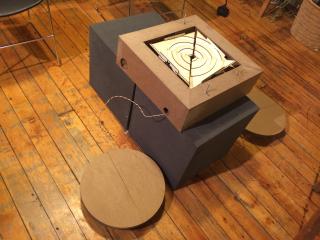Dimelsa Medina
Sharon De La Cruz
Balance Box
For the "Balance Box" project we will be testing users' perceived teamwork as they strive to balance a ball and create a perfect harmony.
http://itp.unoseistres.com/?p=431

Classes
Introduction to Physical Computing
Introduction to Physical Computing
During ITP most projects require us to work in groups or teams of people. This can lead to a more stressful situation as cultural differences and ways of communication come into play. The "Balance Box" project hopes to visualize "true" teamwork, instead of perceived teamwork, by having users balance a ball together. Now this may seem easy but imagine juggling one ball with three other people…not so easy anymore, huh?
User will also be triggering a harmony (based on the balls position) so that users not only see if they are in balance but can hear it as well. Users will control their individual flaps by standing on a balance rig that mimics their movement.
Here is our prototype: http://itp.unoseistres.com/?p=431
and
Schematic: http://itp.unoseistres.com/?p=395
Background
We drew inspiration by the "sew saw client" project in the "Making Things Talk" book.
Audience
Our target audience are ITP students who've worked in groups in the semester.
User Scenario
Four people gather
Each person gets on a balance rig placed paralleled to a side of the balance box (this is the flap you are in control of)
A user places a ball provided on their side of the flap
The balance game begins!
Implementation
We've started our prototype with mat board and cardboard. We are going to transition to chipboard for the box and wood for the balance rig.
Conclusion
We learned that controlling flaps with an accelerometer is HARD!
We learned that the design of our balance box was self explanatory.
We broke our sketch plenty of times! We started off by burning our motors because we had a short circuit, then be burned our Arduino until finally we decided that different power sources are necessary.
User will also be triggering a harmony (based on the balls position) so that users not only see if they are in balance but can hear it as well. Users will control their individual flaps by standing on a balance rig that mimics their movement.
Here is our prototype: http://itp.unoseistres.com/?p=431
and
Schematic: http://itp.unoseistres.com/?p=395
Background
We drew inspiration by the "sew saw client" project in the "Making Things Talk" book.
Audience
Our target audience are ITP students who've worked in groups in the semester.
User Scenario
Four people gather
Each person gets on a balance rig placed paralleled to a side of the balance box (this is the flap you are in control of)
A user places a ball provided on their side of the flap
The balance game begins!
Implementation
We've started our prototype with mat board and cardboard. We are going to transition to chipboard for the box and wood for the balance rig.
Conclusion
We learned that controlling flaps with an accelerometer is HARD!
We learned that the design of our balance box was self explanatory.
We broke our sketch plenty of times! We started off by burning our motors because we had a short circuit, then be burned our Arduino until finally we decided that different power sources are necessary.

